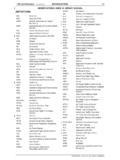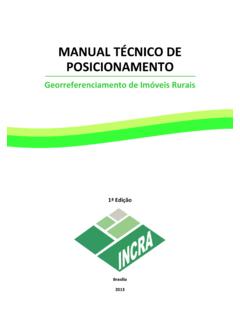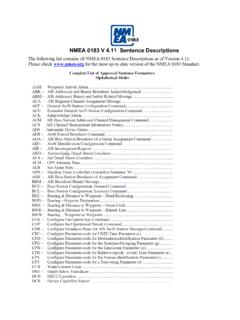Transcription of AVIONICS MADE SIMPLE - drmoe.org
1 AVIONICS made SIMPLE . By Mouhamed Abdulla Jaroslav V. Svoboda Luis Rodrigues Montr al, Qu bec, Canada Copyright 2005 by M. Abdulla All rights reserved. No part of this work shall be reproduced, stored in a retrieval system , or transmitted by any means, electronic, mechanical, photocopying, recording, or otherwise, without written permission from the author. No liability is assumed with respect to the use of the information contained herein. The information provided is on an as is basis. Although every effort and precaution has been taken in the preparation of this book, the author assumes no responsibility for errors or omissions. Nor is any liability assumed for damages resulting from the information contained herein. ABOUT THE AUTHOR. Mouhamed Abdulla received the degree in Electrical Engineering in December-2002 from Concordia University, Montr al, Qu bec, Canada.
2 Presently, he is on the verge of finishing his in Aerospace Engineering through the direct supervision of Dr. Luis Rodrigues also at Concordia University. Mouhamed is currently employed at IBM Canada Ltd. as a Support Specialist for IBM/Lenovo products. He has professional affiliations, including, among others, IEEE, AIAA, and OIQ. His research interests include VLSI design, VLSI process technology, DSP, and AVIONICS . He can be reached at ii To the most precious person of my life: To My Mother iii ACKNOWLEDGMENT. First and foremost, I would like to express my sincere gratitude and respect to the late Dr. Jaroslav V. Svoboda. He was my first contact to this exciting field, and a true mentor to the many students that he had over the years including myself. May his soul rest in peace and he will always be with us in our hearts and thoughts.
3 I am also grateful to my supervisor Dr. Luis Rodrigues for his guidance, support and encouragement. I also like to thank Dr. Marius Paraschivoiu for giving me the chance to work on this project. Further, I would like to thank Professor Anwar Abilmouna for extremely insightful information on avionic system design that he acquired over the many years in industry. Last but not least, I would like to thank Ms. Leslie Hosein for always taking the time to answer my many questions on administrative issues and deadlines. iv PREFACE. The purpose of this book is to present aerospace electronic systems, also known as AVIONICS , in a logical and comprehensible fashion. In fact, when we talk of AVIONICS we usually refer to the following 20 acronyms: ADF TACAN LORAN-C GPS ILS-GS0. NDB VORTAC OMEGA ALS MB. VOR RNAV INS / IRS VASIS MLS. DME RMI / HSI DNS ILS-LOC DGPS.
4 These acronyms form the basics and fundamentals of AVIONICS . Now you might ask yourself: what new is this work bringing? After all many authors with large amount of experience in the field have written books on the subject; many conference papers have tested and studied aspects of AVIONICS ;. hundreds if not thousands of websites on the worldwide web have avionic related documents. To answer the question above I need to mention that it is definitively true that information exist, and naturally I have used relevant information in this book from the above sources. However, most of the information sources available to the world, books, papers, and websites, come short in the following: They don't include all basic avionic systems in a single piece of work. Usually the reader must look at different locations to get the fundamentals of a system .
5 Even if by luck we come across a work that does include relevant information, it usually fails in organization, presentation, and optimization of the data. v Many books are filled with so much information that as an example by the 20th page on a specific avionic hardware, we will completely forget the main purpose of the system . In other words, we would not even know what output is expected using that specific AVIONICS . Most probably in such a scenario, the author either diverged to a different side- topic or maybe he/she might have concentrated on a specific aspect of the system and forget the bigger picture. Because of the reasons outlined above, among others, I decide to once and for all explain AVIONICS in a systematic fashion with clear and concise terms. Consequently, this book should also be proven to be effective as a refresher on a particular technology.
6 Say in five or even ten years from now, we could simply target the chapter and section of interest and obtain the fundamentals of a system in matter of minutes [fundamentals usually don't change with time or maybe change with a slow rate; data on the other hand would most probably be outdated by then]. In is often said by professionals in the field of literature and language, that to teach someone [ students] about something [ basic AVIONICS ] one needs to use the method of questioning. In fact, this logical method is based on six interrogations also known as 5W+H: WHAT: What is the purpose of this system ? What is the useful output that I am getting after using this system ? WHO: Who is permitted to use this system ? Civilian? Military? or Both? WHERE: Where is this system located? On the ground? In the aircraft? In space? HOW: How does this system work?
7 What are the logical steps [block diagrams] in the operation of this system ? WHY: Why is this system good [advantages]? or Why is it bad [disadvantages]? WHEN: When was this system certified as a liable avionic tool? What is the future of this system ? Will it be phased-out? or Will it survive? And if so for how long? vi I will try as much as possible to provide sufficient answers to these questions. In fact, the strategy and logic used to provide SIMPLE answers to the above interrogations are as follows: I will first look for the answers from the class notes of our very own Concordia professor, the late Dr. Jarslov Svoboda. In case I don't find the answers there or that I need a second opinion or that I am simply not sure of the integrity or validity of the of the data due to fast innovations of avionic technologies, I will refer to other sources as enumerated in the reference section of this book.
8 I am pleased and honored to have Dr. Luis Rodrigues as my supervisor for this work. His contribution consists mainly on reviewing the topics; provide constructive comments, and enforce the rules and regulations in regard to copyrights. The book is written in point format approach without excessive details so that it is easy to read and memorize. As for the layout of the information, it is presented in an organized and an optimized fashion. In the sense that if different systems with similar purpose are explained, then a symmetrical structure will be outlined to simplify the comparison study among technologies. Moreover, a major emphasis is given to the illustrations and diagrams to facilitate the understanding of the material. Most of the diagrams were illustrated using Visio Professional available from Visio Corporation. To be more specific, the illustrations used throughout this book are classified into 7 types: Illustrations created fully with Visio using my personal understanding of a topic.
9 Illustrations that I have seen in class notes, and then reproduced exactly the same thing using Visio. vii Illustrations that I have seen in class notes, and then modified it using Visio. Usually when I recreate a figure that I have seen in a related source [class notes or websites], I. will modify it by either making it SIMPLE or even more complex so that it becomes complete yet easy to understand. Illustrations that I have seen in class notes, and then recreated fully the same thing using Visio, with modifications to reflect my perception of the subject. Illustrations found on the worldwide web available to the general public. Illustrations that I have seen on the worldwide web, and then modified it using Visio. Illustrations that I have seen on the worldwide web, and then recreated fully the same thing using Visio, with modifications.
10 Also, on occasions, a programming code is used to facilitate quick calculation for a specific transformation. The code will be based on the Matlab programming language available from MathWorks Inc. As far as the content is concerned, it is partitioned into two major sections: Preliminary and AVIONICS . The Preliminary section does not discuss avionic systems; it is there to assist the reader on general aerospace facts that could be useful once the avionic section is reached. The 20 acronyms listed above would be explained in the AVIONICS section, which in principle forms the essence of this book. Now since the major theme of this work is efficiency, then naturally we should deduce that avionic systems would not be discussed equally. In other words, systems that have retired or that are on the verge of being phased-out will be discussed briefly; where as systems that are important today and have promising improvement for the future will be explained in-depth.



